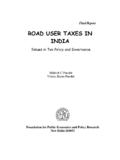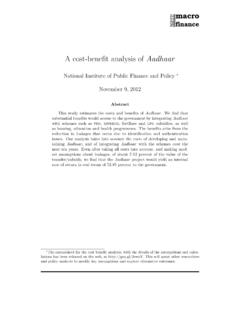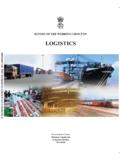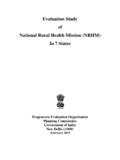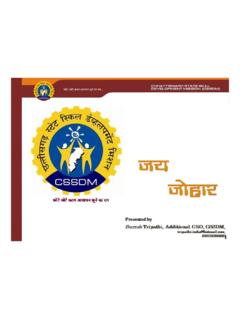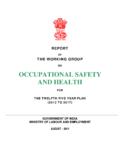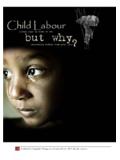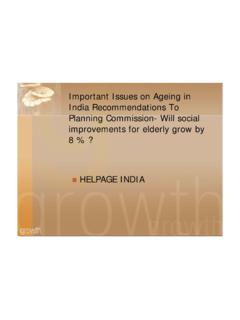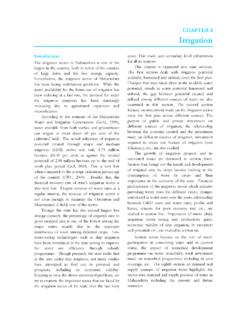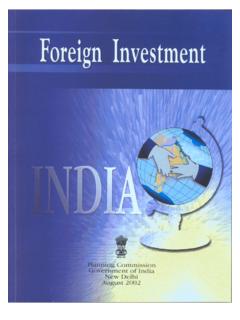Transcription of A Critical Assessment of the Existing Health Insurance ...
1 A Critical Assessment of the Existing Health Insurance Models in India 31st January 2011. Sponsored under the Scheme of Socio-Economic Research, The Planning Commission of India, New Delhi A Research Study Submitted By Public Health Foundation of India 1. A Critical Assessment of the Existing Health Insurance Models in India Prof. K. Srinath Reddy Project Director & President, PHFI. Dr. Sakthivel Selvaraj Principal Investigator, PHFI. Dr. Krishna D. Rao, Mr. Maulik Chokshi, and Dr. Preeti Kumar Co-Investigators, PHFI. Ms. Vandana Arora and Dr. Sachin Bhokare Research Associates, PHFI. Ms. Isheeta Ganguly Consultant, PHFI. 2. Acknowledgements At the outset, this work owes a lot to the initiative and encouragement of Mr. Montek Singh Ahluwalia, Deputy Chairman, Planning Commission, Government of India and by Dr. Sethi, Senior Advisor ( Health and Family Welfare), Planning Commission, Government of India. This project was carried out in technical partnership with the World Bank team comprising Dr.
2 Jerry La Forgia and Dr. Somil Nagpal. Most of our field visit to collect data and estimates were worked out in close partnership with them. However, the interpretations and recommendations of this report are of our own. Ms. Sofi Bergkvist, Access Health International, ISB, Hyderabad was also instrumental in helping us access data from the Rajiv Aarogyasri Trust, Hyderabad and therefore we thank her. This exercise would not have been possible without the generous help from Mr. Anil Swarup, IAS, Director General (Labour Welfare) his team comprising Dr. Nishant Jain of GTZ, Mr. Changqing Sun of the World Bank provided us with relevant materials and data whenever required. We are equally grateful to all the Principle Secretaries/CEOs of States/Schemes (Tamil Nadu, Karnataka, Andhra Pradesh, Rajasthan, Delhi and Himachal Pradesh). Their teams in respective states offered us both technical and logistics support in timely and adequate manner. Our special thanks are also due to the heads and their teams at the Central Government Health Scheme (CGHS) and Employees' State Insurance Scheme (ESIS).
3 They facilitated us to acquire timely and adequate data & documents. Finally, while the analysis, interpretations & policy suggestions were of our own, however, if there are any errors it cannot be attributed to the schemes or the institutions representing them. 3. Table of contents Contents Page No. Acknowledgement 3. Executive Summary 10-15. Chapter 1 Preamble 16-22. Introduction 16. The Context 17. Overall Objectives 19. Specific Objectives of the Study 20. The Methodology (Key Data Sources) 20. Structure of the Report 21. Chapter 2 Key Design Features of Health Insurance Schemes in 23-39. India. Introduction 23. Coverage 24. Various Forms of Health Insurance 26. Mandatory Health Insurance 26. Voluntary Health Insurance 27. Key Design Features of Government Sponsored Insurance Schemes 28. Revenue Collection 29. Risk Pooling 31. Purchasing 32. Provision of Care 36. Summing Up 39. Chapter 3 Institutional Framework of Health Insurance Schemes 40-54. Introduction 40.
4 Implementing Agencies 40. Monitoring and Evaluation 44. Internal Control Mechanisms 45. Cost Containment 46. The Enrolment Process 47. 4. The Premium Collection Process 48. Claims Processing 49. Widespread Use of Information Technology Systems 50. Choosing the Providers 51. The Missing Focus on Quality 53. Accreditation of Facilities 53. Summing Up 54. Chapter 4 Governance and Regulation of Health Insurance 55-65. Schemes Introduction 55. Governance and Health Insurance 56. Decision Making Structures 56. Stakeholder Participation 61. Transparency and Information 61. Supervision and Regulation 63. Insurers and Providers 64. Summing Up 65. Chapter 5 The Problem of Asymmetric Information 66-79. Introduction 66. The Hospitalization Patterns in Various Schemes 67. Expenditure Pattern under Different Programs 72. The Emerging Malpractices and Corruption 75. Chapter 6 Fiscal Sustainability and Scalability of Health Insurance 80-90. Schemes The Geometry of Health Insurance Coverage 80.
5 How sustainable are Current Health Insurance Schemes? 83. Can Rising Claims Ratio Scuttle the Nascent Health Insurance 88. Programs? Chapter 7 The Way Forward 91-100. Are the Current Publicly funded Schemes Sustainable and Scalable? 91. How Scalable is RSBY? 91. The Role of CGHS and ESIS 92. The Road Ahead: An Integrated model 92. Insurance as an Option to Cover Outpatient Treatment 93. 5. Health Insurance for the Non-Poor 96. Summing Up 98. References 101-102. Websites 103. Appendix 104-115. Annexure 1 Matrix 104-110. Annexure 2 Annexure 1- Scheme wise Benefit Package 111. Annexure 3 Procedure/Therapy wise Variation in Pricing of Packages 112. Annexure 4 Percentage of Claimed Amount Paid under Different 114. Schemes Annexure 5 Commercial Health Insurance : Disease-wise Number of 115. Claims, Amount Claimed and Paid for 2005-06. Chart & Figures Page No. Figure The Landscape of Health Insurance Scheme In India 24. Chart National and State wise Health Insurance Coverage in 2010 25.
6 Chart What type of care does the scheme provide? 33. Chart Percentage of Private and Public Hospitals Networked by 37. Schemes - 2010. Chart Distribution of Hospital-wise Claims Under Different 37. Schemes 2009-10. Chart Institutional Structure of Rashtriya Swasthaya Bima Yojana 42. (RSBY). Chart Institutional framework of Rajiv Aarogyasri Scheme (AP) 44. Chart Cost containment mechanisms under various schemes 46. Chart Decision makers and their responsibilities under Rajiv 59. Aarogyasri Scheme Chart Decision makers and their responsibilities under RSBY 60. Chart Disease-wise distribution of claims 71,72. Chart Top 20 Network Hospitals in pre authorised claims 77. Chart Breadth, Depth and Height of Health Insurance Schemes 81. Chart Utilization trends under various schemes 84. Chart Percentage of Rural Households Falling BPL due to Health 94. Care Expenditure Chart Percentage of Urban Households Falling BPL due to Health 95. Care Expenditure Chart India's Population by Different Expenditure Class, 2004-05 95.
7 Chart Distribution of Poor and Vulnerable by Workforce 97. Categories Chart Distribution of Poor and Vulnerable by Workforce 98. Categories 6. Tables Page No. Table Scheme-wise Health Insurance Coverage 26. Table Sources of revenue under various Insurance schemes 29. Table Benefit Packages under Insurance Schemes 35. Table Variation in Package Rates for Similar Procedures, 2009-10. 38. (in Rs.). Table Implementing Agency, Insuring Agent and Human Resources 41. Table Premium Rates and Coverage Amount under Different 49. Schemes Table Distribution of Network Hospitals 52. Table Expenditure Summary of CGHS 56. Table Income Expenditure Summary, ESIC 57. Table Summary of ESIC funds investment 58. Table Rates of Hospitalisation in RSBY-Implementing States, 2009- 68. 10. Table Hospitalisation Rates in State-Based Health Insurance 69. Schemes Table RSBY - Average Hospitalisation Expenditure in Different 73. States Table Average Hospitalisation Expenditure - Scheme wise 74.
8 Table Contributions of Health Insurance and Tertiary Care Spending 85. Table Contributions of Health Insurance and Tertiary Care Spending 86. Table Claims Ratio in RSBY-Implementing States, 2009-10 89. Table Scheme-wise Claims Ratio, 2009-10 89. Table India's Population by Different Expenditure Class, 2004-05 97. 7. Glossary AP Andhra Pradesh BPL Below Poverty Line CA Chartered Accountant CBHI Community Based Health Insurance CGHS Central Government Health Schemes ESIC Employee State Insurance Corporation ESIS Employee State Insurance Scheme FFS Fee for Service FHPL Family Health Plan Ltd. GDP Gross Domestic Product HI Health Insurance HP Himachal Pradesh IT Information Technology IRDA Insurance Regulatory Development Authority KN Karnataka MoLE Ministry of Labour and Employment NABH National Accreditation Board for hospitals and Health care providers NABL National Accreditation Board for Testing and Calibration Laboratories NGO Non-Governmental Organisation NRHM National Rural Health Mission NSSO National Sample Survey Organisation OOP Out of Pocket PHFI Public Health Foundation of India PHI Private Health Insurance RAS Rajiv Aarogyasri Scheme RBI Reserve Bank of India RE Revised Estimates RSBY Rashtriya Swasthya Bima Yojana SAS Suvarna Arogya Suraksha Trust SNO State Nodal Agency SEWA Self-Employed Women's Association 8.
9 TPA Third Party Administrator TN Tamil Nadu TNHSP Tamil Nadu Health System Project TNMSC Tamil Nadu Medical Services Corporation Ltd VAS Vajapayee Arogyasri Scheme VAO Village Administrative Officer 9. Executive Summary Global experience, both in highly industrialised countries as well as in low- and middle-income economies clearly demonstrate the importance of achieving universal coverage through either a purely tax-based regime or social Health Insurance mechanisms or a mix of both. Although India followed a mix of these strategies since 1950s, the penetration of Health Insurance remained low for the next six decades. India's tryst with Health Insurance program goes back to the early 1950s, with the launch of Employees State Insurance Scheme (ESIS in 1952) and Central Government Health Scheme (CGHS in 1954). However, India's landscape of Health Insurance has undergone tremendous changes in the last three years with the launch of several more Health Insurance schemes in the country, largely initiated by central and state governments.
10 It is fascinating to observe the rapid and significant change in the geometry of Health Insurance coverage in the country. The country that has been witness to three Health Insurance programs until 2007 (ESIS, CGHS and Private Health Insurance - PHI), is now swamped by a plethora of Insurance programs, in less than three years time. The breadth, depth and height of Health Insurance coverage has witnessed enormous leap during this period. The breadth of the coverage- denoted by the percentage of population covered by the Insurance scheme has accelerated from about 75 million people covered (roughly about 16 million family beneficiaries) in 2007, to an estimated 302 million people in 2010, about one-fourth of the population. Thanks to four important initiatives, by the central government (through Rashtriya Swasthya Bima Yojana - RSBY) and state- sponsored schemes, as in Andhra Pradesh, Tamil Nadu, and Karnataka. Three of the giant schemes (RSBY, Rajiv Aarogyasri and Kalaignar) in a span of three years have covered roughly 247 million, over one-fifth of India's population.
